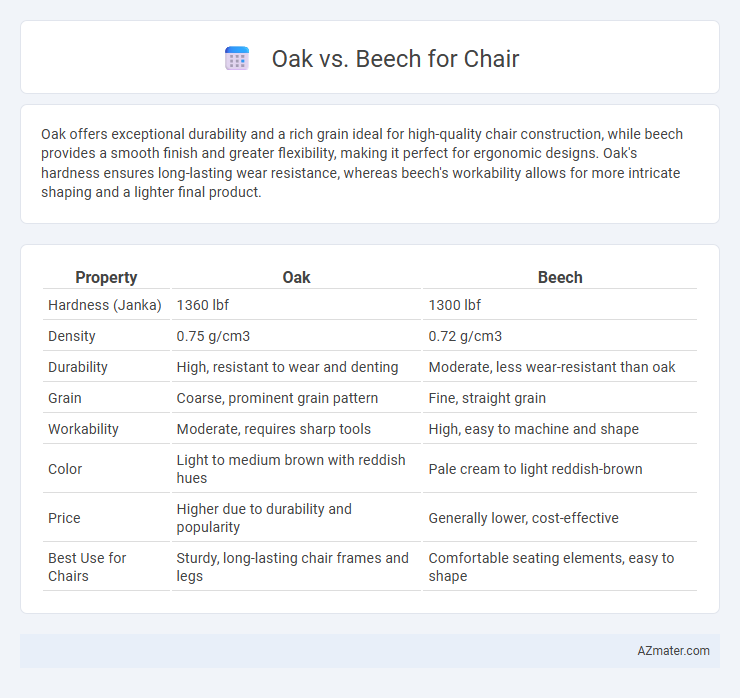Oak offers exceptional durability and a rich grain ideal for high-quality chair construction, while beech provides a smooth finish and greater flexibility, making it perfect for ergonomic designs. Oak's hardness ensures long-lasting wear resistance, whereas beech's workability allows for more intricate shaping and a lighter final product.
Table of Comparison
| Property | Oak | Beech |
|---|---|---|
| Hardness (Janka) | 1360 lbf | 1300 lbf |
| Density | 0.75 g/cm3 | 0.72 g/cm3 |
| Durability | High, resistant to wear and denting | Moderate, less wear-resistant than oak |
| Grain | Coarse, prominent grain pattern | Fine, straight grain |
| Workability | Moderate, requires sharp tools | High, easy to machine and shape |
| Color | Light to medium brown with reddish hues | Pale cream to light reddish-brown |
| Price | Higher due to durability and popularity | Generally lower, cost-effective |
| Best Use for Chairs | Sturdy, long-lasting chair frames and legs | Comfortable seating elements, easy to shape |
Introduction: Oak vs Beech Chairs
Oak chairs offer exceptional durability and a rich, pronounced grain, making them ideal for long-lasting furniture with classic appeal. Beech chairs provide a smooth texture and pale hue, lending a contemporary and versatile aesthetic suited for modern interiors. Both hardwoods balance strength and comfort, with oak excelling in robustness and beech favored for its fine finish and workability.
Key Differences Between Oak and Beech Wood
Oak wood is renowned for its exceptional durability and prominent grain patterns, making it ideal for sturdy, long-lasting chairs that showcase natural texture. Beech wood offers a smoother, more uniform appearance with a lighter color and fine grain, resulting in chairs with a sleek, modern aesthetic and excellent shock resistance. While oak is harder and more resistant to wear, beech is easier to shape and finish, providing versatility in design and comfort for chair construction.
Strength and Durability Comparison
Oak offers superior strength and durability for chair construction, featuring a dense grain that resists wear and heavy use, making it ideal for long-lasting furniture. Beech, while also hard and strong, is slightly less dense than oak and can be more prone to dents and scratches over time. Both woods provide excellent stability, but oak's higher hardness rating (approximately 1360 Janka) ensures greater resistance to impacts and structural integrity.
Appearance and Grain Patterns
Oak chairs feature a prominent grain pattern with natural knots and rays, giving a rustic and textured appearance ideal for traditional or farmhouse styles. Beech chairs exhibit a finer, more uniform grain with a smooth surface and light, creamy color that complements modern, minimalist designs. Oak's darker, warm hues contrast with beech's pale tones, influencing the overall aesthetic and mood of chair design.
Workability and Craftsmanship
Oak offers excellent workability with its coarse grain and high density, allowing craftsmen to achieve durable, sturdy chairs that age gracefully. Beech wood features a fine, tight grain and smooth texture, making it ideal for intricate carvings and precise joint work in chair making. Both woods support exceptional craftsmanship, but beech's uniformity allows for easier machining and finishing, while oak provides superior strength and a classic aesthetic.
Comfort and Ergonomics
Oak chairs offer robust durability and a firm seating experience, ideal for users seeking solid support; the wood's density provides excellent resistance to wear, maintaining ergonomic form over time. Beech chairs feature a smoother finish with slight flexibility, delivering enhanced comfort through subtle cushioning effects and better contouring to the body's shape. Both woods support ergonomic design principles, but beech's lighter weight and responsive texture often result in superior comfort for prolonged sitting.
Cost and Availability
Oak chairs typically cost more due to the wood's density and durability, making it a premium choice for furniture. Beech wood is generally more affordable and widely available, thanks to its faster growth rate and abundant supply in temperate regions. Availability of oak can be limited depending on geographic location, whereas beech is commonly sourced, reducing lead times and costs for manufacturing chairs.
Maintenance and Longevity
Oak chairs require minimal maintenance due to their dense grain and natural resistance to wear, making them highly durable over decades. Beech chairs often need more frequent upkeep, such as polishing or oiling, to prevent drying and cracking, especially in fluctuating humidity. Longevity for oak typically surpasses beech, with oak maintaining structural integrity and appearance under heavy use much longer.
Environmental Impact and Sustainability
Oak chairs generally have a lower environmental impact due to the tree's slower growth and durability, which extends the furniture's lifespan and reduces the need for frequent replacements. Beech wood, while also renewable, comes from faster-growing trees that enable quicker reforestation but may result in a shorter product lifespan compared to oak. Sustainable sourcing certifications like FSC ensure responsible harvesting practices for both woods, promoting forest regeneration and biodiversity conservation.
Which Wood is Best for Your Chair?
Oak offers superior durability and strength, making it ideal for chairs that require long-lasting support and resistance to wear. Beech features a fine grain and smooth texture, providing excellent machinability and a lighter color that complements modern aesthetics. Choosing between oak and beech depends on whether you prioritize robustness and traditional appeal or a sleek finish and ease of shaping.

Infographic: Oak vs Beech for Chair
 azmater.com
azmater.com